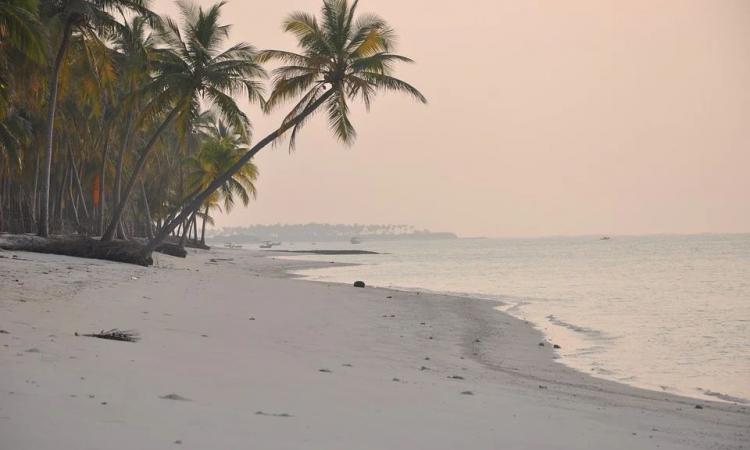
Rising global sea levels as a consequence of climate change is likely to permanently inundate many small islands in future. A study based on climate projections of sea-level rise and associated coastal inundation of Lakshadweep Islands indicates the potential inundation that may occur.
The small archipelago of Lakshadweep in the Arabian Sea characterized by low elevations was modelled by a team from the Indian Institute of Technology (IIT), Kharagpur recently. The islands although classified as atolls, differ vastly in their morphology from the typical atolls observed in the Pacific and the Indian Ocean in that there is no central lagoon rimmed by land. Lakshadweep atoll lagoons have land formations on one side and ocean on the other side.
The study by a team of scientists projecting different greenhouse gas scenarios indicates that sea levels will rise around the Lakshadweep Islands between 0.4 mm per year to 0.9 mm per year and will affect airport and residential areas. This is for the first time that climate model projections have been used to assess the potential areas of inundation over the archipelago of Lakshadweep Islands in the Arabian Sea.
The paper ‘Climate projections of sea-level rise and associated coastal inundation in atoll islands: Case of Lakshadweep Islands in the Arabian Sea’ highlights that the worst possible inundation scenarios projected for Lakshadweep Islands are almost similar under different emission scenarios and all the islands in the archipelago would be vulnerable to impact from the rise in sea levels.
The team included Aysha Jennath, Athira Krishnan, Saikat Kumar Paul, Prasad K Bhaskaran, jointly from the Department of Architecture and Regional Planning and Department of Ocean Engineering and Naval Architecture, IIT Kharagpur, with support from the Department of Science and Technology, Government of India under the Climate Change Programme (CCP).
The methodology involved evaluating the performance of CMIP5 Global Climate Models (GCMs) in simulating the sea level rise in the Arabian Sea using various statistical methods. GFDL-ESM2G and MIROC5 were found to be the best performing models in predicting the sea-level rise under various Representative Concentration Pathway (RCP) scenarios. An RCP is a greenhouse gas concentration (not emissions) trajectory adopted by the Intergovernmental Panel on Climate Change (IPCC).
It estimated that smaller islands Chetlat and Amini are expected to have a major land loss. Projection mapping indicated that about 60-70 per cent of existing shoreline would experience land loss in Amini and about 70-80 per cent in Chetlat.
Although the maximum sea surface height values for the period of 2080–2100 predicted by the models i.e., 0.78 m is less than the global sea-level rise projected by the IPCC (0.8–2.0 m), it does not imply that the islands are safe from rising sea levels. The projections obtained from the best performing models were then used to map the potential inundation that may occur under RCP 2.6, 4.5, and 8.5 scenarios.
The study indicates that all the islands within the archipelago may be vulnerable to the effects of sea-level rise, with the capital Kavaratti projected to experience inundation along much of its coastline under all forcing scenarios.
As per the paper, “the islands have experienced an increase in population growth and land development in the past decades and suffer from scarcity of land. The land use pattern in the islands is such that most of the residential areas occur along the periphery of the islands and cultivation in the centre, increasing the vulnerability of the islands to rising sea levels and erosion. Fisheries, agriculture and tourism are the three main economic sectors of the islanders, all of which are also vulnerable to the impacts from sea-level rise and storm events.”
The present work highlights that larger islands Minicoy and the capital Kavaratti are also vulnerable to sea-level rise, and expected to experience land loss along 60 per cent of the existing shoreline. Sea level rise effects are seen to have the least impact on Androth Island under all emission scenarios.
The research that was published in the journal 'Regional Studies in Marine Science, Elsevier’ recently showed that the coastal inundation could have a wide socio-economic impact.
According to the team, projected inundation due to sea-level rise can impact the islanders as residential areas are quite close to the present coastline.
Also, the only airport in the archipelago is located at the southern tip of Agatti Island and has a high likelihood of damage due to inundation from sea level rise.
The authors have suggested that keeping in view the impacts from the projected sea-level rise for Lakshadweep, it is necessary to have appropriate coastal protection measures and best practices to formulate planning guidelines.
This study looks at future research to assess the directional nature of wave energy, the impact of storminess in the Arabian Sea region, islands that are exposed and sheltered and amenities such as potable water, sanitation and so on.